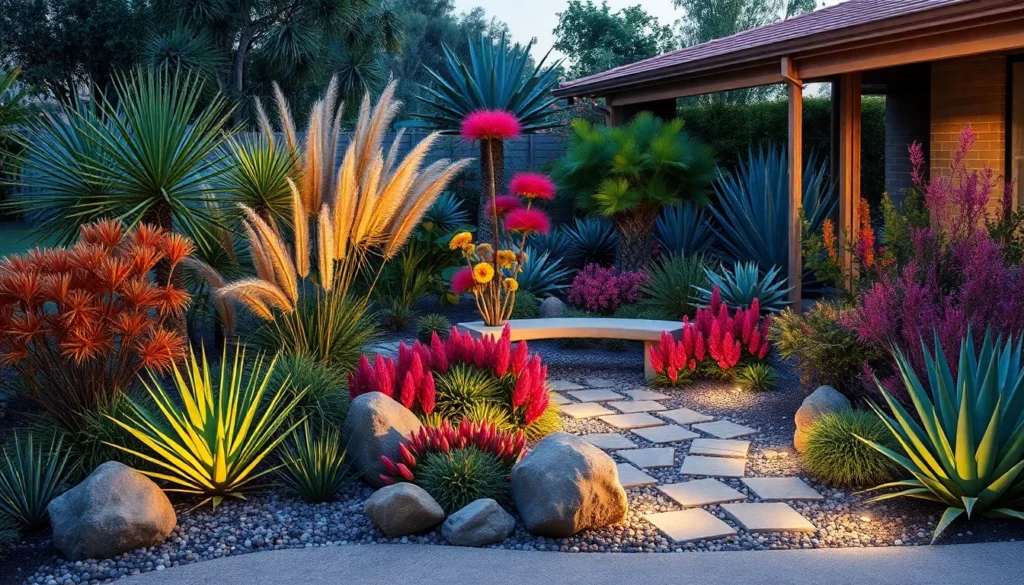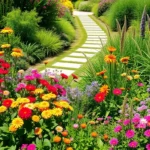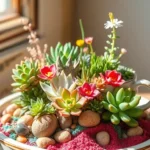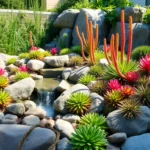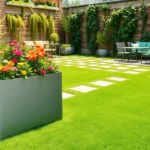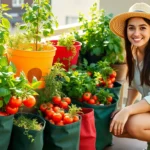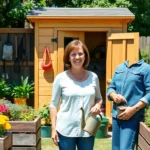Creating a stunning front garden in Australia requires more than just planting a few flowers and hoping for the best. With our unique climate challenges ranging from scorching summers to unpredictable rainfall patterns we need smart design choices that’ll thrive year-round while boosting our home’s curb appeal.
We’ve discovered that the most successful Australian front gardens combine native plants with water-wise landscaping techniques. This approach not only reduces maintenance time but also creates landscapes that naturally complement our local environment. From drought-tolerant succulents to colorful native flowering shrubs there’s an abundance of options that’ll transform any front yard into a welcoming entrance.
Whether you’re working with a compact suburban space or a sprawling country property we’ll show you how to maximize impact while minimizing effort. These proven front garden ideas will help you create an outdoor space that’s both beautiful and practical for Australian conditions.
Create a Welcoming Entrance With Native Australian Plants
Native Australian plants transform your front garden into a stunning entrance that thrives in our climate. These hardy species require minimal water while delivering maximum visual impact throughout the year.
Choose Drought-Tolerant Kangaroo Paw and Grevillea
Kangaroo Paw creates striking focal points with its unique fuzzy flowers that bloom in vibrant reds, yellows, and oranges from spring through autumn. We recommend planting Anigozanthos flavidus varieties like ‘Bush Gold’ or ‘Bush Ranger’ as they handle full sun and poor soils exceptionally well. Position these plants in clusters of three to five for dramatic effect near your front entrance.
Grevillea shrubs provide year round color and attract native birds to your garden space. Spider flower varieties such as Grevillea ‘Robyn Gordon’ produce continuous pink and red blooms while reaching heights of 3 to 5 feet. Plant these versatile natives as hedging along pathways or as specimen plants in garden beds. Their needle like foliage adds fine texture contrast against broader leafed companions.
Incorporate Colorful Bottlebrush and Banksia Varieties
Bottlebrush trees deliver spectacular cylindrical flowers that burst with color from red to pink to cream depending on the variety you select. Callistemon viminalis ‘Little John’ works perfectly for smaller front gardens, growing only 3 feet tall while producing bright red brushes. We suggest placing these compact varieties near windows or entryways where their blooms create instant curb appeal.
Banksia species offer unique sculptural forms with their distinctive cone shaped flower heads and serrated leaves. Coastal banksia (Banksia integrifolia) tolerates salt spray and sandy soils, making it ideal for properties near the ocean. Old man banksia (Banksia serrata) provides dramatic height up to 15 feet with its characteristic bottlebrush flowers that age to woody seed pods.
Add Texture With Australian Grasses and Sedges
Australian grasses create movement and softness in your front garden design while requiring virtually no supplemental watering once established. Lomandra longifolia varieties like ‘Tanika’ form neat clumps of strappy green foliage that stay attractive year round. These versatile plants work brilliantly as border edging or mass plantings beneath taller native shrubs.
Sedges bring fine textural interest and natural flow to garden beds and pathway edges. Carex appressa (tall sedge) grows in moist areas and produces graceful arching stems up to 4 feet high. Ficinia nodosa (knobby club rush) creates dense tufts of blue green foliage perfect for coastal conditions where salt tolerance matters most. We often combine different grass heights and colors to establish visual layers that guide visitors toward your front door.
Design Low-Maintenance Mediterranean-Style Gardens
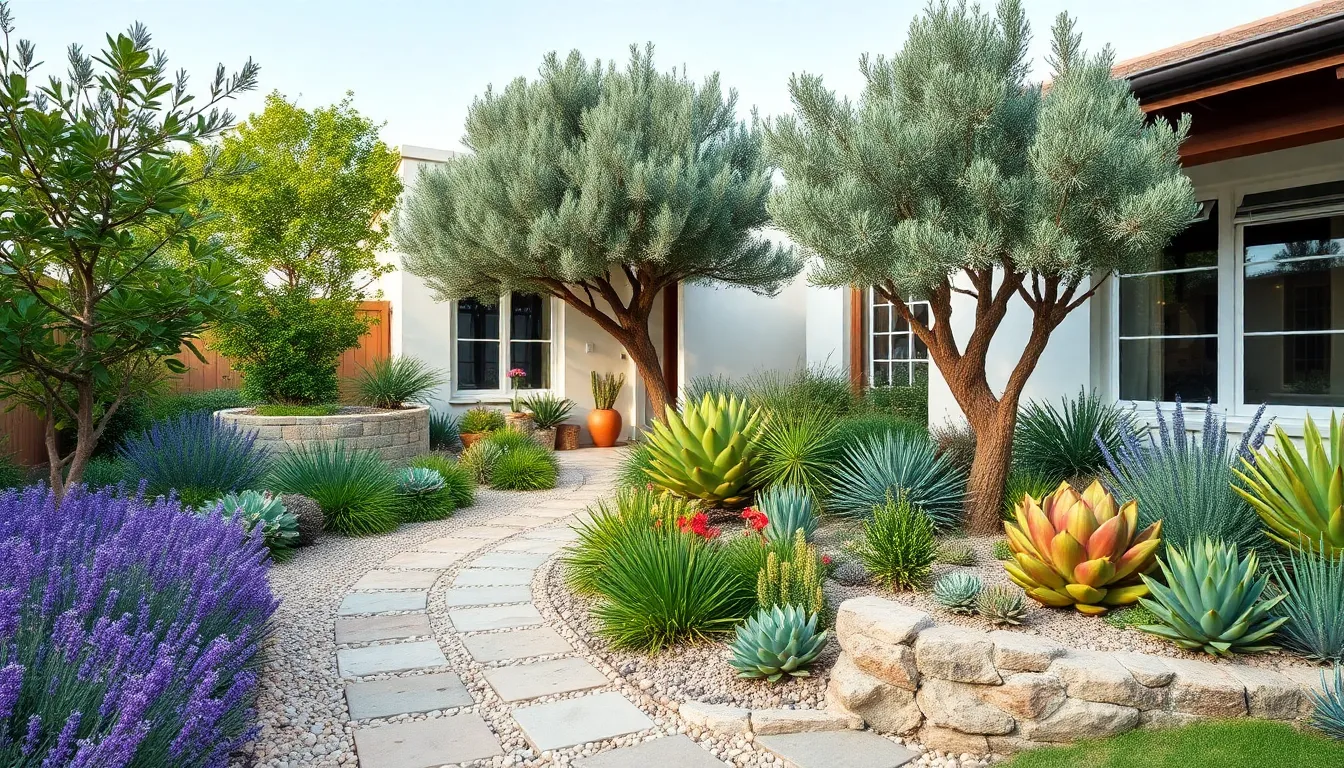
Mediterranean style gardens offer the perfect solution for Australian front yards that need visual appeal without constant upkeep. We’ll show you how to create this timeless look using drought resistant elements that thrive in our climate.
Install Gravel Pathways and Stone Features
Gravel pathways create the foundation of any authentic Mediterranean garden design. We recommend using crushed limestone or decomposed granite in warm tones like cream, beige, or terracotta to complement your home’s exterior. These materials require minimal maintenance compared to traditional lawn pathways and provide excellent drainage during heavy rainfall periods.
Stone features add instant character to your front garden industry. Natural sandstone retaining walls work beautifully for sloped properties, while decorative boulders can create focal points near your entrance. Limestone pavers arranged in geometric patterns bring Old Industry charm to larger front yard spaces.
Water runoff becomes manageable when you incorporate permeable stone surfaces throughout your design. Gravel prevents soil erosion while allowing rainwater to filter naturally into the ground rather than pooling on hardscaped surfaces.
Plant Lavender, Rosemary, and Olive Trees
Lavender varieties like English lavender and Spanish lavender provide year round structure with their silvery foliage and fragrant purple blooms. We suggest planting these drought tolerant perennials along pathway edges or as low hedging around seating areas. Their aromatic qualities naturally deter pests while attracting beneficial pollinators to your front garden.
Rosemary shrubs offer both culinary value and industry appeal with their needle like leaves and small blue flowers. These hardy plants grow well in poor soils and require watering only during extended dry periods. Prostrate rosemary works excellently as ground cover, while upright varieties can serve as informal hedging.
Olive trees make stunning statement plants for larger front yards with their distinctive gnarled trunks and silver green foliage. Choose dwarf varieties like Arbequina or Picual for smaller spaces, as these compact trees rarely exceed 8 feet in height. Their Mediterranean heritage means they’ll flourish in Australian conditions with minimal water requirements once established.
Create Water-Wise Succulent Displays
Succulent gardens bring modern Palm Springs style to traditional Mediterranean landscapes through their architectural forms and varied textures. We recommend grouping different species like Agave americana, Aloe vera, and Echeveria varieties to create visual interest without overwhelming your design scheme.
Retro breezeblocks serve as perfect planters for displaying succulent collections while adding geometric structure to your front garden layout. These concrete blocks provide excellent drainage and can be arranged in various configurations to suit your space requirements.
Statement palm trees like Mediterranean fan palms or dwarf date palms complement succulent displays beautifully. Position these focal plants strategically to frame your entrance or create privacy screening along property boundaries. Their minimal water needs align perfectly with water wise gardening principles essential for Australian conditions.
Build Stunning Contemporary Front Yard Landscapes
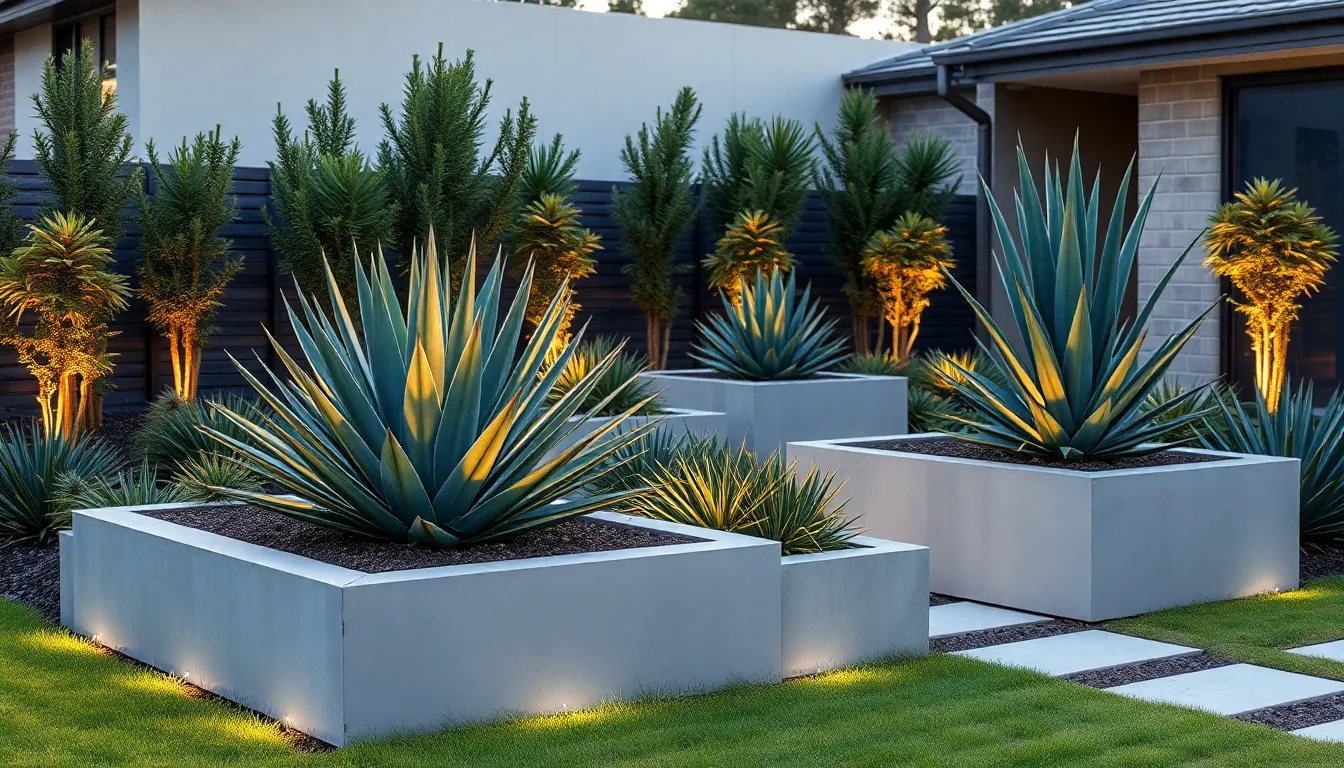
Contemporary front yard designs in Australia blend modern aesthetics with practical elements that thrive in our diverse climate conditions.
Incorporate Clean Lines With Modern Planters
Geometric planters transform your front yard into a sophisticated outdoor space that complements architectural features. We recommend selecting sleek containers made from concrete, metal, or wood materials that add modern touches to garden designs. Large rectangular planters work particularly well for creating structured borders along pathways and driveways.
Strategic placement of these modern containers creates visual balance throughout the industry design. Position matching planters symmetrically near your entrance or arrange them in geometric patterns across different garden zones. This approach establishes clean lines that guide the eye naturally through your outdoor space.
Material selection for contemporary planters should complement your home’s exterior finishes and color palette. Concrete planters offer durability and weather resistance while providing neutral tones that highlight colorful plantings. Metal options like cor-ten steel develop attractive patina over time and suit industrial-style architecture perfectly.
Use Architectural Plants Like Agave and Yucca
Agave varieties provide dramatic focal points with their striking geometric forms and minimal maintenance requirements. These architectural plants thrive in Australia’s climate conditions and create bold visual statements that anchor contemporary garden designs. Popular species include Agave americana and Agave attenuata, which offer different sizes and growth patterns.
Yucca plants complement modern landscapes with their sword-like foliage and sculptural presence throughout the year. We suggest positioning these statement plants as corner features or entrance markers where their architectural qualities can be fully appreciated. Their drought tolerance makes them ideal for Australian front yards with limited irrigation systems.
Native architectural options expand your plant palette while supporting local ecosystems and reducing water requirements. Consider incorporating Australian grass trees (Xanthorrhoea) or pandanus varieties that provide similar structural impact with enhanced environmental benefits. These indigenous choices require less maintenance than exotic alternatives while offering unique textures and forms.
Add Dramatic Lighting for Evening Appeal
Ground-level lighting transforms architectural plantings into stunning nighttime features that enhance your property’s curb appeal. We recommend installing LED spotlights at the base of agave and yucca plants to create dramatic shadow patterns against walls and fences. This technique highlights the plants’ sculptural qualities while providing practical pathway illumination.
Solar-powered options offer energy-efficient answers that minimize environmental impact while delivering consistent performance. Modern solar lights provide sufficient brightness for accent lighting and require minimal installation effort compared to hardwired systems. Position these fixtures strategically to illuminate key design elements without creating harsh glare.
Layered lighting design creates depth and visual interest by combining different light sources at various heights throughout the industry. Install uplights for tall architectural plants, path lights for walkway safety, and accent lights for modern planters to achieve comprehensive evening illumination. This multi-level approach ensures your contemporary front yard remains visually appealing after dark.
Establish Traditional Cottage Garden Charm
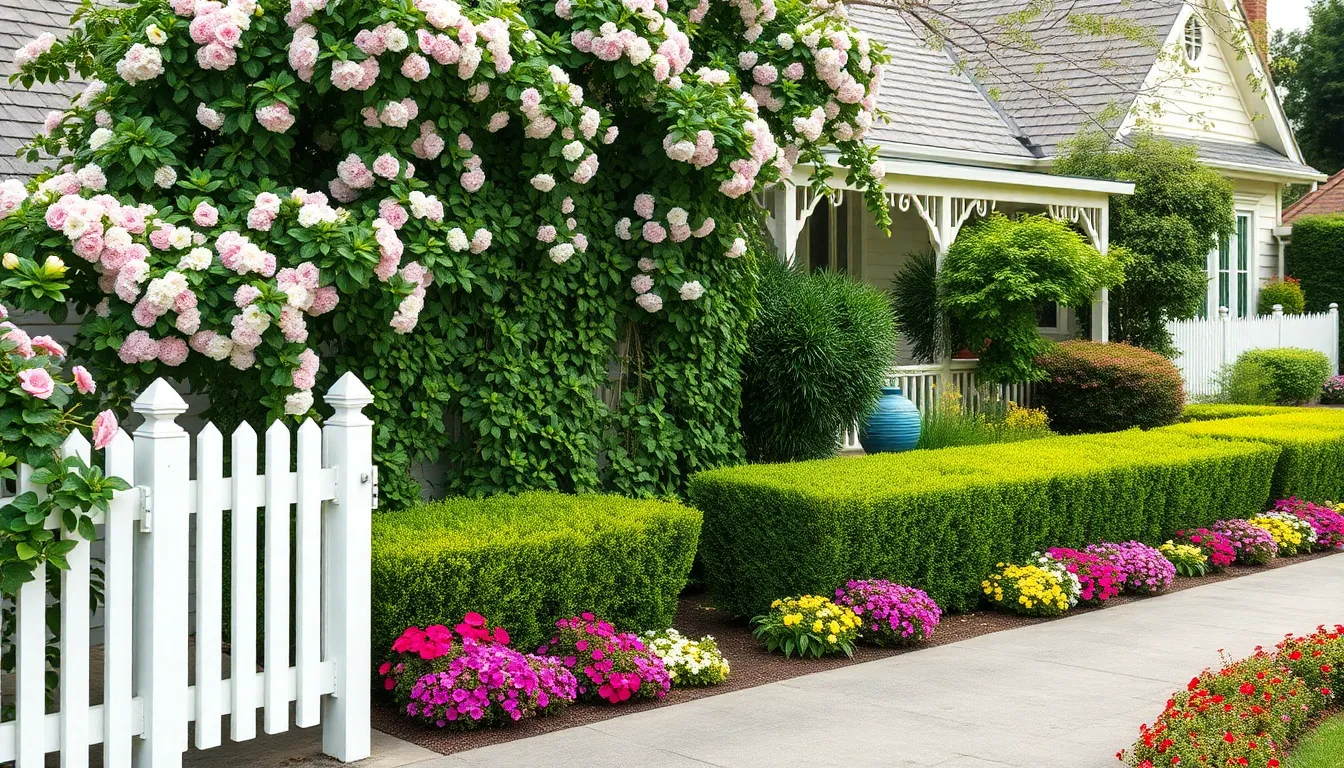
We can transform any Australian front garden into a romantic cottage haven by incorporating classic English design elements adapted for our climate. These timeless features create an inviting atmosphere that perfectly complements modern landscaping trends.
Plant English Box Hedging and Rose Borders
English box hedging creates the perfect foundation for cottage garden design in Australian gardens. Buxus sempervirens thrives in our diverse climate zones and provides year round structure for your front yard. We recommend planting these hedges along pathways or property boundaries to establish clear garden rooms.
Rose borders add fragrance and classic cottage appeal when paired with box hedging. Choose disease resistant varieties like David Austin roses or climbing roses that handle Australian heat well. Plant these beauties in front of the hedging to create layered depth and seasonal interest.
Combine these elements with native groundcovers to reduce water requirements while maintaining the cottage aesthetic. This pairing ensures your garden stays lush during dry spells while delivering that quintessential English charm.
Create Picket Fence Boundaries With Climbing Vines
Wooden picket fences serve as the quintessential cottage garden boundary for Australian front yards. Install white painted timber pickets at chest height to define your space without blocking natural light. We suggest using treated pine or cedar for longevity in our variable weather conditions.
Climbing vines transform plain fencing into living walls of beauty and privacy. Clematis varieties like Montana or Jackmanii create spectacular spring displays while handling Australian sun exposure. Wisteria produces cascading purple or white blooms that make stunning focal points during flowering season.
Train these climbing plants along fence lines using wire supports or trellis systems. Regular pruning keeps growth manageable while encouraging abundant blooms that enhance your cottage garden’s romantic appeal.
Include Seasonal Color With Annuals and Perennials
Annuals provide instant cottage garden color that changes with Australia’s distinct seasons. Marigolds and zinnias deliver vibrant yellows, oranges, and reds during warmer months while requiring minimal water once established. Plant these colorful additions in clusters for maximum visual impact.
Perennials offer long term cottage charm with reliable yearly displays. Daisies create classic white and yellow combinations that complement any color scheme. Native violets add purple highlights while attracting beneficial insects to your garden network.
Mix these plantings throughout your cottage borders to ensure continuous color from spring through autumn. We recommend choosing varieties with staggered blooming periods to maintain visual interest year round while supporting local wildlife populations.
Install Water-Smart Garden Solutions
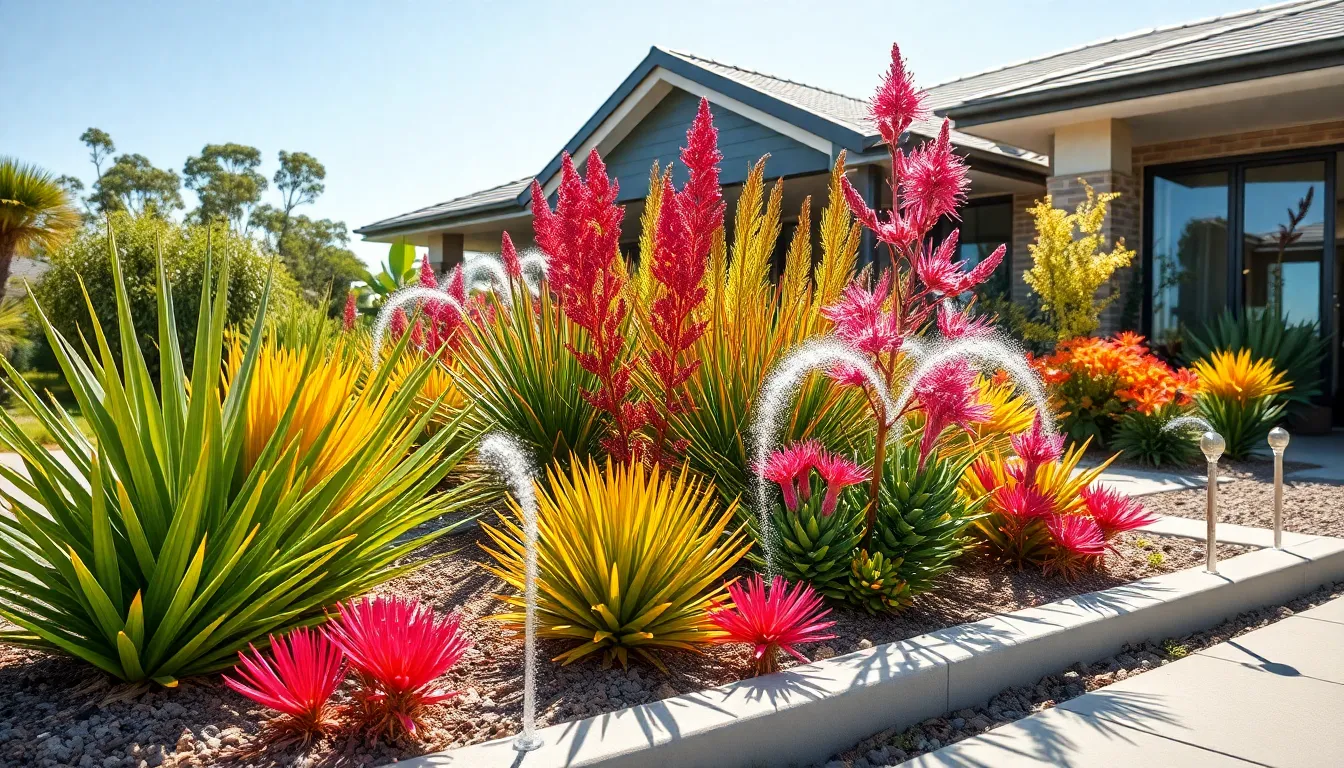
Australia’s challenging climate demands strategic water management in our front gardens. We can create stunning landscapes while conserving precious water resources through proven irrigation techniques, smart plant selection, and moisture retention strategies.
Set Up Drip Irrigation Systems for Efficiency
Drip irrigation systems deliver water directly to plant roots, making them the most efficient watering method for Australian gardens. We recommend installing these systems to reduce water waste by up to 50% compared to traditional sprinkler systems.
Benefits of drip irrigation include:
- Delivering water precisely where plants need it most
- Minimizing evaporation losses during hot Australian summers
- Reducing weed growth by keeping soil surface dry
- Preventing fungal diseases that thrive in wet foliage conditions
Installation involves placing emitters near each plant’s root zone and connecting them to a timer controlled mainline. We suggest using pressure compensating emitters to ensure consistent water delivery across your entire front garden system.
Choose Plants Suited to Your Climate Zone
Australia’s diverse climate zones require different plant selections for optimal water efficiency. We must match our plant choices to local rainfall patterns and temperature ranges to minimize irrigation needs.
For arid regions, drought tolerant natives like:
- Kangaroo Paw varieties that thrive with minimal water
- Grevillea species offering colorful blooms year round
- Native grasses requiring only seasonal watering
For tropical areas, select plants that handle high humidity:
- Frangipani trees providing fragrant flowers
- Bromeliad ground covers thriving in moisture
- Native palms suited to wet season conditions
Temperature considerations also matter when selecting climate appropriate plants. We recommend choosing species that can withstand your area’s extreme temperatures without requiring excessive watering for survival.
Carry out Mulching Strategies to Retain Moisture
Mulching helps retain soil moisture, reduce erosion, and limit weed growth throughout our Australian front gardens. We can cut watering needs by 25-40% through proper mulching techniques.
Organic mulch options include:
- Shredded hardwood bark lasting 2-3 years
- Sugar cane mulch breaking down to improve soil
- Leaf mold created from composted autumn leaves
- Pine bark chips providing long lasting coverage
Application techniques require spreading mulch 2-4 inches thick around plants while keeping material away from plant stems. We should refresh organic mulches annually to maintain their moisture retention properties and visual appeal.
Inorganic alternatives like decorative stones or quartzite pebbles offer permanent answers for succulent gardens and modern landscapes. These materials reflect heat while providing excellent drainage for water sensitive plants.
Design Functional Front Garden Zones
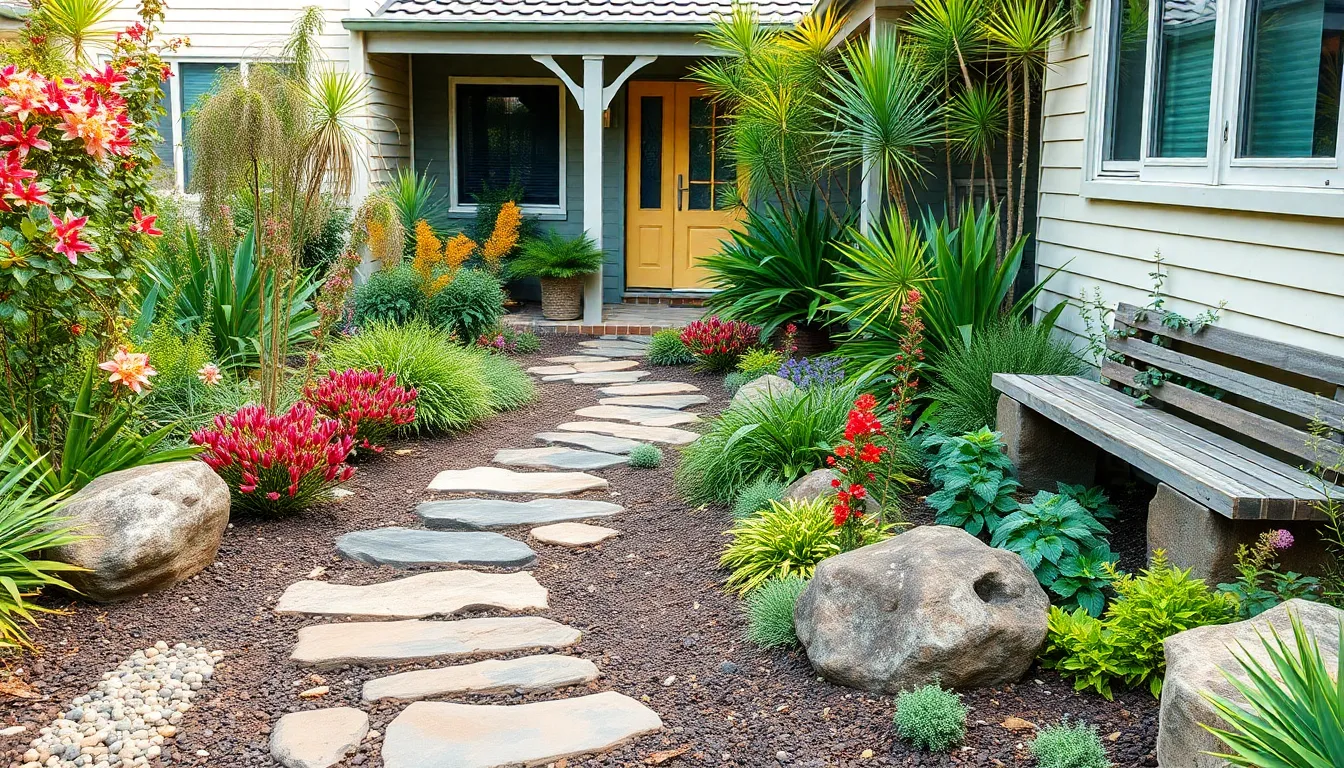
We’ll transform your front garden into distinct zones that maximize both beauty and practicality. Strategic zoning creates structure while ensuring every square meter serves a purpose.
Create Dedicated Parking and Pathway Areas
Rustic pathways guide visitors through your garden using organically shaped stepping stones that create an inviting atmosphere. These natural elements blend seamlessly with Australian landscapes while providing clear navigation from street to front door. Recycled hardwood sleepers offer another pathway option that adds character and sustainability to your design.
Patio patterns define gathering spaces using irregularly shaped pavers for unique visual interest or fixed shape pavers for traditional appeal. Stone materials work particularly well in Australian conditions, handling temperature fluctuations and weather extremes with minimal maintenance. Decorative elements like native rocks and evergreen plantings enhance these hardscaped areas while maintaining year round appeal.
Step lighting transforms pathways into modern design features that provide safety and visual drama after dark. Solar powered options integrate easily with Australian conditions, requiring no electrical connections while delivering reliable illumination throughout the evening hours.
Establish Privacy Screening With Strategic Plantings
Thick hedges positioned strategically behind existing fences create layers of privacy while maintaining attractive streetscape appeal. Dense plantings like native Lilly Pilly or Murraya work exceptionally well in most Australian climates, providing evergreen screening that requires minimal water once established.
Ivy frames around front porches create enchanting natural boundaries that soften harsh architectural lines. Fast growing native alternatives like Pandorea or Hardenbergia offer similar coverage with better drought tolerance and wildlife benefits. These climbing answers provide privacy without blocking natural light or creating imposing barriers.
Screening plants should match your climate zone for best results, with drought tolerant natives like Bottlebrush or Grevillea working well in arid regions while moisture loving species suit tropical areas. Layered plantings using trees, shrubs, and groundcovers create depth and visual interest while maximizing privacy benefits.
Include Storage Answers Hidden Within Landscaping
Large planters serve dual purposes by housing beautiful displays while concealing storage compartments underneath or within their structure. These functional elements can hold garden tools, outdoor cushions, or seasonal decorations without compromising your design aesthetic.
Garden benches with built in storage compartments provide seating areas while hiding maintenance supplies or children’s outdoor toys. Materials like treated timber or powder coated steel work well in Australian conditions, handling sun exposure and moisture without deteriorating quickly.
Decorative elements like ornamental boulders or raised garden beds can incorporate hidden storage spaces for irrigation controls, lighting transformers, or pool equipment. Creative integration ensures these practical necessities remain invisible while maintaining easy access for maintenance and seasonal adjustments.
Add Hardscaping Elements for Year-Round Interest
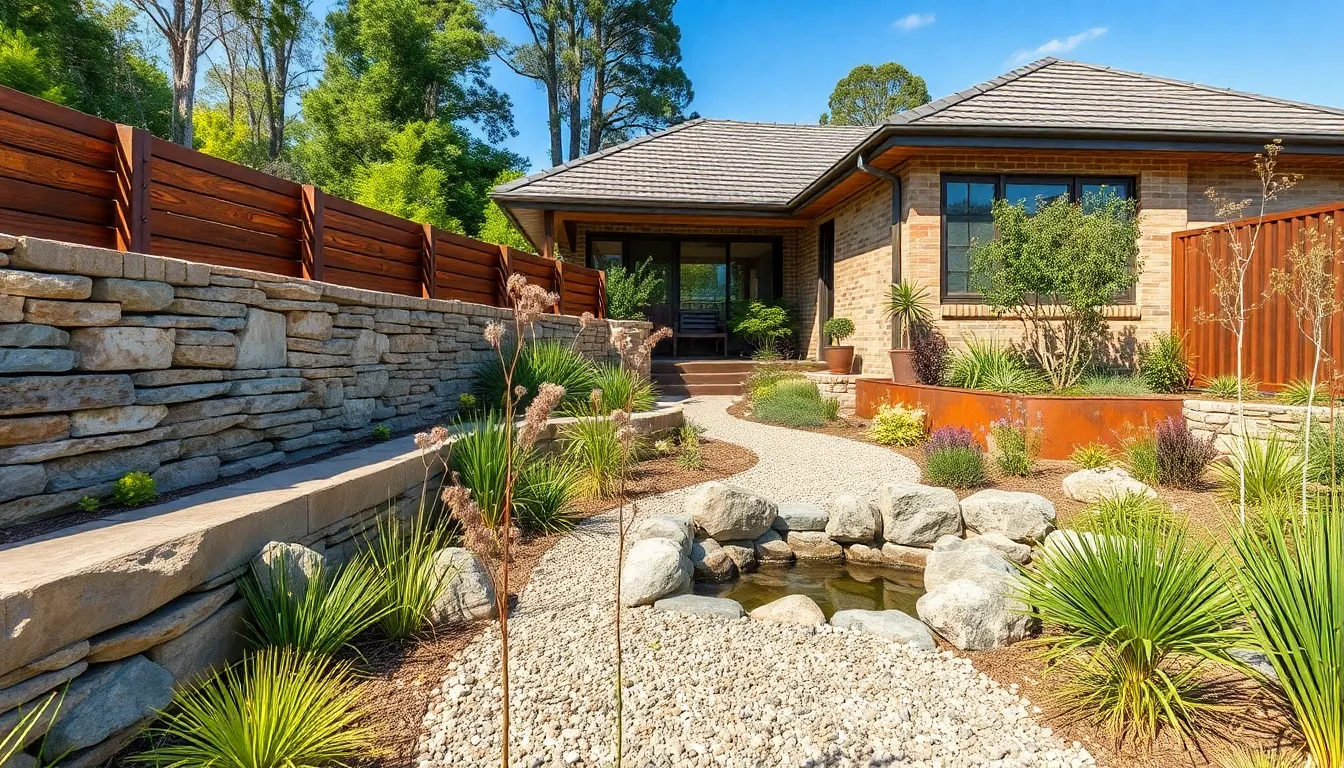
Hardscaping elements provide the backbone of Australian front gardens, offering structure and visual appeal regardless of seasonal changes. These permanent features create lasting beauty while reducing maintenance requirements in our challenging climate.
Install Decorative Stone Walls and Retaining Features
Stone edging transforms ordinary garden beds into defined, elegant spaces. Natural materials like sandstone or timber create clean boundaries that separate different garden areas while adding sophisticated detail. We recommend using these materials to frame pathways or highlight exact planting zones.
Recycled hardwood sleepers offer versatile functionality for modern Australian gardens. These sustainable materials work perfectly for building retaining walls or creating decorative elements that guide visitors toward your front door. Their natural weathering process adds character over time while maintaining structural integrity.
Corten steel retaining walls provide contemporary appeal with minimal upkeep. This weathering steel develops a protective rust patina that eliminates the need for painting or sealing. We’ve found these walls particularly effective for creating terraced gardens on sloped properties.
Decorative rocks and gravel add textural interest while supporting water retention. Different sizes and colors of decorative stones create visual layers that complement planted areas. These elements help reduce water evaporation from soil surfaces during Australia’s hot summer months.
Create Outdoor Living Spaces With Seating Areas
Patio patterns using irregularly shaped pavers establish inviting gathering spaces. These custom designs move beyond standard rectangular layouts to create unique outdoor rooms. We suggest incorporating native plantings between pavers to soften hard edges and maintain connection with the garden.
Statement porches enhance front entrances while providing functional outdoor living areas. Adding built-in seating or decorative elements like potted plants creates welcoming transition zones. A beautifully painted door becomes the focal point that ties together these enhanced entrance features.
Stepping stone pathways guide movement while creating opportunities for small seating nooks. Strategic placement of wider stones or small platforms allows for informal perching spots throughout the garden journey. These elements work particularly well when combined with fragrant plantings that engage visitors as they pause.
Incorporate Water Features for Tranquil Ambiance
Small urns or fountains introduce soothing water sounds that mask street noise. Wall-mounted fountains work exceptionally well in compact front gardens, providing the calming effects of moving water without requiring important space. We recommend models with gentle trickles rather than dramatic splashes for residential settings.
Modern succulent gardens combine beautifully with retro water features. Palm Springs-inspired designs featuring geometric planters and subtle water elements create low-maintenance focal points. These combinations work particularly well in contemporary Australian gardens where water conservation remains essential.
Wildlife-attracting water features support local ecosystems while improving garden appeal. Shallow basins or small ponds encourage native birds and beneficial insects to visit your front garden. Position these features where they’re visible from inside your home to maximize enjoyment throughout the day.
Plan for Seasonal Color and Interest
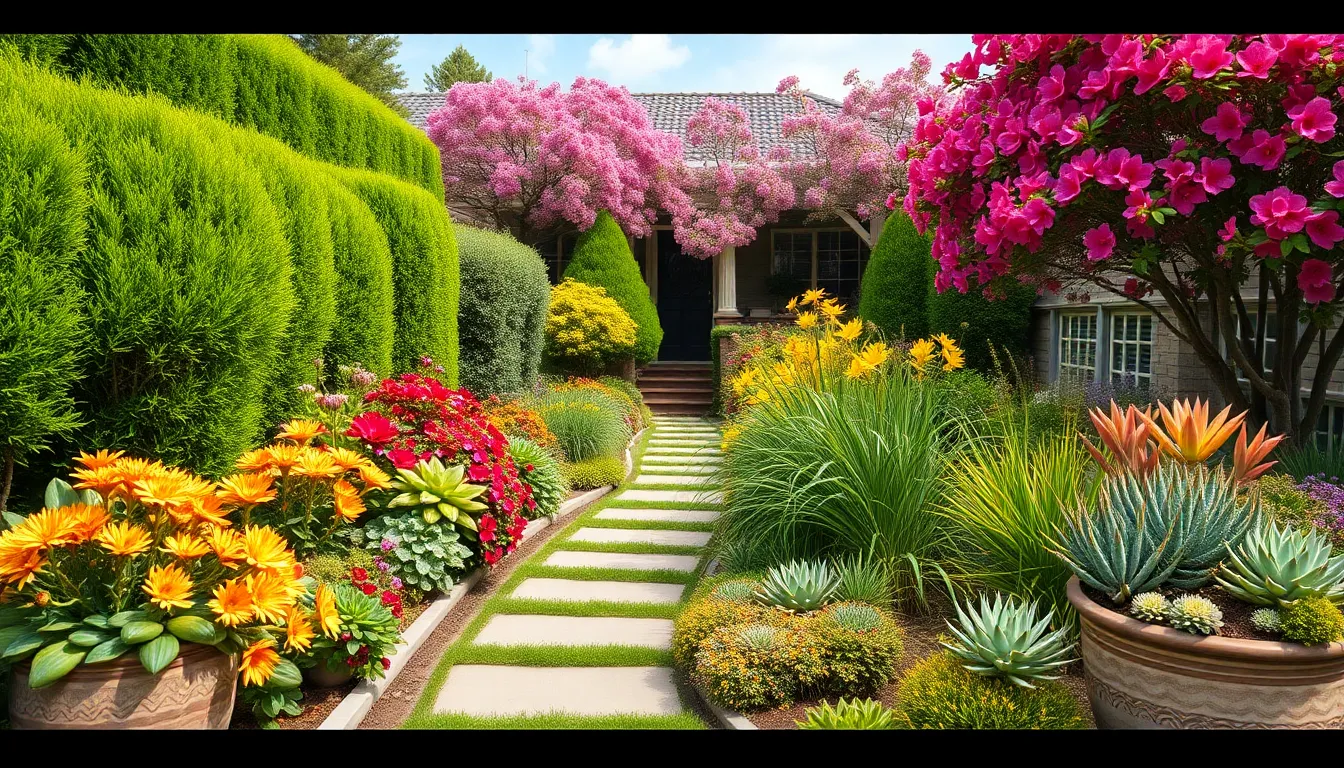
We’ll transform your Australian front garden into a year-round spectacle by strategically planning for continuous visual appeal across all seasons.
Select Plants With Varying Bloom Times
Choose native plants with staggered flowering schedules to ensure your front garden maintains color throughout the year. Kangaroo paw delivers vibrant orange and red blooms from spring through summer, while native daisies provide cheerful white and yellow flowers during cooler months. We recommend incorporating native violets for their delicate purple blooms in autumn and winter.
Plant flowering trees for structural impact and seasonal drama in your front garden design. Crepe myrtle offers spectacular summer blooms in pink, white, or purple, creating stunning overhead canopies. Frangipani trees provide fragrant white and yellow flowers during warmer months, adding tropical elegance to your Australian industry.
Layer perennial bloomers with annual varieties to maximize color diversity across seasons. Hardy perennials like Australian native grevilleas bloom repeatedly throughout the year, while seasonal annuals like marigolds and zinnias deliver intense bursts of color during their peak growing periods.
Include Evergreen Structure Plants for Winter Appeal
Install clipped hedge plants for year-round structure that maintains your garden’s framework during dormant seasons. Buxus hedging provides consistent green backdrops and geometric shapes, ensuring your front garden retains its polished appearance even when flowering plants aren’t blooming.
Position architectural evergreen shrubs as focal points that anchor your seasonal plantings. Native bottlebrush varieties offer striking red cylindrical flowers while maintaining their distinctive foliage year-round. Australian grass trees create dramatic sculptural elements with their spiky crowns and sturdy trunks.
Create layered evergreen foundations using plants of varying heights and textures. Low-growing native sedges provide soft groundcover movement, while mid-height shrubs like westringia offer silvery-green foliage and small white flowers throughout winter months.
Add Seasonal Container Gardens for Flexibility
Use moveable planters for adaptable seasonal displays that we can refresh based on blooming schedules and weather conditions. Large ceramic or concrete containers allow us to swap out seasonal annuals like petunias in spring and chrysanthemums in autumn without disrupting permanent plantings.
Plant drought-tolerant succulents in containers during Australia’s intense summer months for low-maintenance color options. Agave varieties provide architectural interest with their geometric forms, while colorful echeveria species offer rosette patterns in blues, purples, and silvers that thrive in hot conditions.
Design container groupings with varying heights to create ever-changing seasonal vignettes near entrances and pathways. We can combine tall statement plants like cordylines with trailing varieties like native violets, adjusting arrangements seasonally to highlight different color combinations and textures.
Conclusion
Creating a stunning front garden in Australia doesn’t have to be overwhelming when you understand the key principles we’ve covered. By focusing on climate-appropriate plants and smart design choices you’ll build a space that’s both beautiful and sustainable.
The strategies we’ve outlined help you balance aesthetic appeal with practical functionality. From water-wise plantings to seasonal color planning each element works together to create a cohesive outdoor space that enhances your home’s curb appeal.
Remember that successful Australian front gardens combine native wisdom with modern design principles. Whether you choose Mediterranean drought-tolerant plants or contemporary hardscaping elements the key is selecting options that thrive in your exact climate zone while reflecting your personal style.
Frequently Asked Questions
What are the best native plants for Australian front gardens?
Kangaroo Paw, Grevillea, Bottlebrush, and Banksia are excellent choices for Australian front gardens. These drought-tolerant natives thrive in local climate conditions, require minimal maintenance, and attract native wildlife. Australian grasses and sedges add movement and texture while being perfectly adapted to the environment.
How can I create a low-maintenance Mediterranean-style front garden?
Install gravel pathways using crushed limestone or decomposed granite for excellent drainage. Plant drought-tolerant species like lavender, rosemary, and olive trees. Add stone features such as sandstone walls and incorporate succulent displays in decorative planters. These elements combine to create an attractive, water-wise garden.
What hardscaping materials work best in Australian climates?
Natural sandstone, recycled hardwood sleepers, and Corten steel are ideal for Australian conditions. These materials provide excellent durability against weather extremes while offering versatility in design. Decorative rocks and gravel also work well, providing texture and helping with water retention and drainage.
How do I design a contemporary front yard suitable for Australia?
Use geometric planters made from concrete, metal, or wood to create clean lines. Plant architectural species like Agave, Yucca, or Australian grass trees for structural impact. Add LED spotlights or solar-powered lighting for evening appeal, creating a modern aesthetic that’s both functional and visually striking.
What’s the best way to manage water in Australian front gardens?
Install drip irrigation systems to reduce water waste by up to 50%. Choose plants suited to your specific climate zone and apply mulch to retain soil moisture. Select drought-tolerant natives for arid regions and group plants with similar water needs together for efficient irrigation management.
How can I create privacy in my front garden without blocking natural light?
Use dense evergreen hedges like Lilly Pilly or Murraya for effective screening. Plant climbing species such as Pandorea or Hardenbergia around porches and fences. These options provide privacy while allowing light to filter through, maintaining an open feel while creating intimate spaces.
What are the best plants for year-round color in Australian gardens?
Select native plants with staggered bloom times, such as Crepe Myrtle and Frangipani for structural impact. Layer perennial bloomers with seasonal annuals like marigolds and zinnias. Include evergreen plants for winter structure and use seasonal container gardens for flexible, adaptable color displays throughout the year.
How do I incorporate storage solutions into my front garden design?
Use large planters with hidden compartments and garden benches with built-in storage for tools and supplies. These dual-purpose elements maintain aesthetic appeal while providing practical functionality. Strategic placement ensures storage remains accessible yet unobtrusive within the overall garden design.

